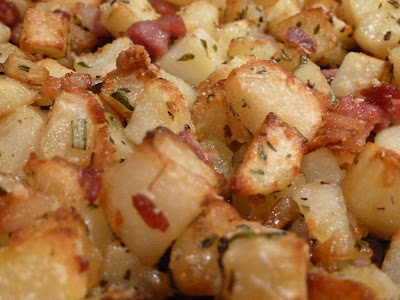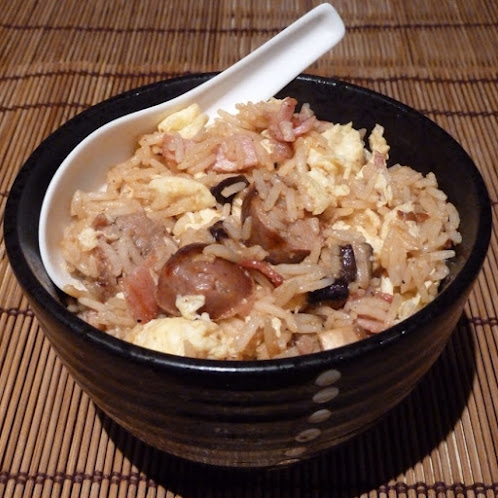So the title of this post sounded a lot less violent in my head, but today I want to blather on for a little bit about one of the most important pieces of equipment in the kitchen: the knife.
The knife is an invaluable piece of kit, because unless you plan to use a chainsaw to massacre your potatoes, or to shred your shallots into chunks with your bare hands like some kind of feral, onion-crazed maniac, you can't get by without a decent blade. When I was younger, using a knife used to scare and intimidate me a little, mainly because of their capability of slicing through your finger just as easily as through a raw sausage - something that I am still fully aware of today. So, I thought I'd share a couple of little tips that might help to make you more comfortable with a blade.
1. Find a knife you're comfortable with
Now this may sound a little odd, but I've found that it really helps. Kitchen knives come in a variety of shapes and sizes, from the long skinny type, to the short dumpy ones. My biggest piece of advice is to find the one you're comfortable with and stick with it. Personally, I love to use the biggest knife that I have - the 12" wide blade - and I use it for everything. I've become so comfortable with it, that using it for whatever I'm chopping or slicing feels right. With the big blade I can easily crush garlic cloves, thinly slice a chicken breast, dice an onion, or chop up fresh herbs. But if a big knife feels too intimidating, go for something smaller. If it's too bulky, pick one with a thinner blade; try different ones, and go with what you prefer. Of course that being siad, there are certain tasks that may require a different type of knife, in which case, use the most appropriate tool, but for everyday cooking, I find it best to use that one knife you're most comfortable with.
2. Make sure the knife is sharp
This really is absolutely imperative. There's nothing more dangerous than a blunt knife, so ensure that your blade is always kept sharp. If it's dull, then it's much more likely that the blade will slip off the item you're trying to cut and head straight in the direction of the nearest finger - and while it may be blunt, it can still do damage. Aside from that, a razor sharp knife, makes any kind of chopping and slicing much, much easier. So keep your knife sharp, as not only are you preventing the loss of digits, but you're making life easier for yourself.
3. Have confidence when using a knife
Yes, this may sound a bit dumb, but it's a worthwhile tip. Don't be too timid when using a knife. Being too aware of what could go wrong, or being overly cautious can sometimes make you more prone to kitchen mishaps. Now I'm not saying go hell for leather and forget the consequences, because that's equally as dangerous, just work carefully and confidently and that brand new box of sticky blue plasters can stay unopened.
4. Work at your own speed
Whenever I watch cookery shows and we see the chef actually preparing the ingredients instead of just tipping them out from one of their "here's one I (meaning some poor lackey) chopped earlier" bowl, the speed with which they use the knife astounds me. There is no way I can chop a carrot at that sort of rate, but you know what, I don't have to. So my next knife tip is to chop, slice and dice at your own pace and when you know how quickly or slowly you work, simply allow the appropriate amount of time when preparing a meal. Hurrying to meet a deadline, will only make you sloppy and stressed, so simply relax, work at a speed that suits you and enjoy cooking.
5. Don't be afraid to cheat a little
Now, by cheat I don't mean going down to the local supermarket and buying a pack of ready chopped onions - that's just lazy. What I mean by this, is don't be afraid of employing the services of a food processor in certain circumstances. For example, there's a ragu recipe that I love, which calls for carrot, celery and red onion to be finely chopped. In this case it's going in a mince dish, so why not make life easier and pop the three vegetables in the food processor and briefly blitz them until they're the desired size. It's quick, effective, and much less hassle than fiddling about with a knife. However, it's only worth employing this method when a recipe specifically calls for particularly fine chopping.
6. Water can be your new best friend
This final tip, is more specific to certain aspects of cooking, and isn't necessary for everyday chopping. At times you may have to cut up something sticky, and this can be a real pain in the rear end as the blade can get really sticky. The best example of this I can think of is if you are making rolled sushi. In trying to cut your big sushi roll into the bitesize pieces they're meant to be, the glutenous rice will often cling to the knife like a particularly needy limpet. This not only makes trying to cut it more difficult, but because there's a certain amount of resistance, you can also end up squashing the sushi roll. Luckily, there's an easy, and miraculous fix. Keep a bowl of water beside you, and before each cut, simply douse the blade. The water will act as a buffer, which will prevent the rice sticking to the knife, and allowing you to smoothly cut through. This same principle also applies to slicing raw sausages, use a little water and the sausagemeat won't stick to the knife; instead you'll have nice clean slices and a much easier job when it comes to washing up the knife. So if you come across something sticky to cut, try wetting the blade.
Well, I think that's it for now, as I've waffled on enough. Hopefully, this has been of some use, and with luck it may help someone out there feel mo confident the next time they pick up a knife in the kitchen.
















